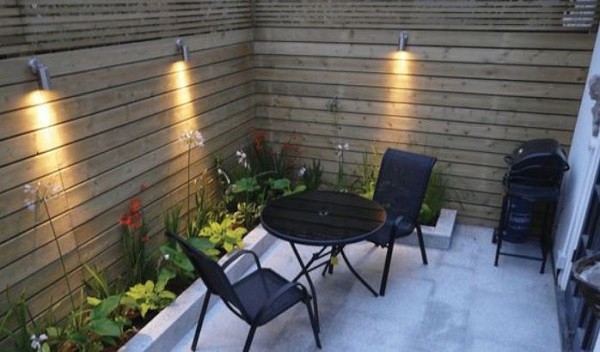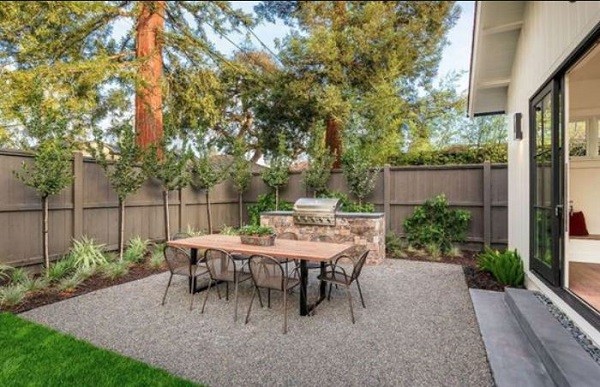
Incorporate a covered patio into your garden or backyard for a simple outdoor room. Patio furniture may be set up for outside dining, morning coffee, or simply unwinding with friends because the concrete floor offers secure footing. To construct a covered patio, you’ll need a gravel or limestone paver base, slabs, sand, and preferred patio material. Stone patio designs can be made from flagstones, pavers, or bricks.
Choose a pattern for your project that avoids cutting the patio material to save time and effort. For a simple task, bricks or pavers laid in straight or slightly curved patterns often work nicely. Flagstones are perfect for a comfortable patio with a natural aesthetic because of their irregular shapes.
How to Construct a Covered Patio
The process of creating a patio is very similar to solving a puzzle. First, create almost consistent spacing between the stones by rotating the pieces until they fit together. Then, use the guide below to learn how to create a patio out of flagstone, brick, or the Highest quality pavers and slabs. For each material, the fundamental stages are the same.
What you’ll require
- Garden hose or stakes and mason line
- Spade
- Tamper or plate compactor
- Wheelbarrow
- Landscape fabric
- Gravel or limestone paver base
- Builder’s sand (also called leveling sand)
- 2 PVC pipe cut to the length of your patio
- 2 by 4 wood
- Flagstones, bricks, or pavers
- Plastic edging (optional)
- Polymeric jointing sand
- Broom
● Defining Your Patio and Get Rid of the Sod
To specify the patio’s shape, lay a garden hose on the ground or use pegs and a mason line. Build a little more than you had planned if you’re unsure about the ideal size for your new location. It can be more difficult to expand a stone patio later than to construct a huge patio from the start.
At the position of the patio, dig out the soil and sod with a sharp garden spade shovel. Create a base 8 inches deep and as thick as the flagstone, brick, paver or slabs. Slope the site away from the exterior of your home if you’re installing a patio close to your house. Create a 1-inch drop every four feet using a level. Use a tamper to compact the dirt once all of the sod has been taken out.
The extra soil can be moved with a wheelbarrow to a compost pile, a low-yard area, or along the foundation.
● Garden fabric can be added to patio bases.
Landscape fabric should be used to cover the excavated area, and it should be cut to size. However, it is not a necessary procedure; this aids in keeping weeds from growing between the patio stones. This weed control technique is quite effective, and landscape fabric is reasonably priced and simple to apply.
● Build a Gravel and Sand Patio Base
Add gravel or limestone paver base to the excavated area, and spread it out to create a 6-inch-deep layer covering the entire patio area. Use a garden hose to mist the limestone paver base if you’re using one. Next, use a tamper or a plate compactor that you may rent for a solid base. Finally, spread a 1-inch-deep layer of builder’s sand on top of any gravel you use. To make a smooth surface, use a tamper or plate compactor.
You must use levelling sand to complete a limestone paver and slab base if you choose to utilise one. Laying two 1-inch PVC pipes down the length of the space is a good place to start. These oughts are to be reduced in size to fit inside the patio base. Place levelling sand 1 inch thick on top. Next, level the PVC pipes by laying your 2×4 across them and sliding the sand across. Sand should be used to close any gaps left by the pipes
● Put Your Stones or Pavers in Place
Start by laying the first flagstones or pavers on one patio side. Sand can be added to the area beneath the stone to provide a virtually level surface. Put the stones together as closely as you can. Large spaces between the stones encourage weed growth, exacerbating the patio surface’s unevenness. Install plastic edging around the outside of your patio if you’d want to, and it’s possible, given the shape of your patio.
● Sand up the patio’s surface
Spread polymeric jointing sand over the patio once the bricks, pavers, or flagstones are in place. Sand should be spread over the pavers with a stiff broom until all cracks are filled. Next, use a low-speed leaf blower to remove extra sand. To assist the sand in settling into the crevices between the stones, spray the area lightly with water from a garden hose. To achieve a long-lasting finish, repeat the steps of adding sand, sweeping, and watering about a week after construction is finished.
● Keep Your Patio Clean
Gather your outdoor furniture, including a few tables, to decorate your new paver patio. Add more sand between the cracks, sweep, and moisten with a hose to maintain a smooth patio surface if the patio stones start to wobble over time (or the sand starts to erode). Plan to pressure wash or scrub the stones with a detergent solution at the start and end of the outdoor season to prevent mildew and stains on your stone patio.
Contact the professionals
Building a patio requires the highest quality pavers and slabs, and you can do it alone at home, but hiring some professional contractors such as Unilock is also a good idea. The options offered in the Unilock Paver collection are unmatched in the market, ranging from conventional shapes and textures to cutting-edge technologies and distinctive styles. Unilock provides pavers for everyone, whether you envision a private patio, a good driveway, or a great outdoor living area. Likewise, whether you’re envisioning a patio for entertaining guests outside or a walkway to guide them to your front door, Unilock has a wide selection of concrete paving stones to suit every style and need.





